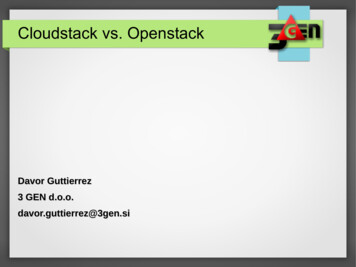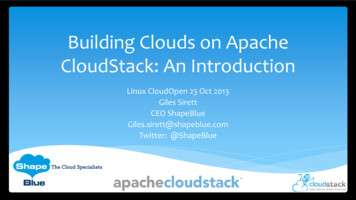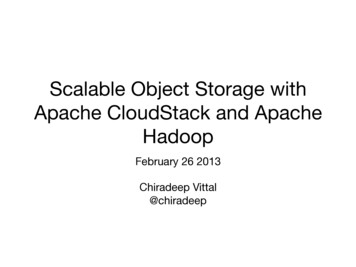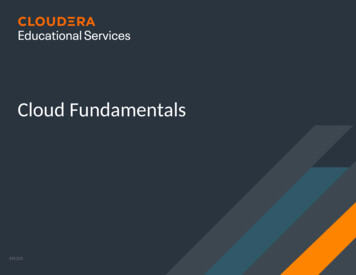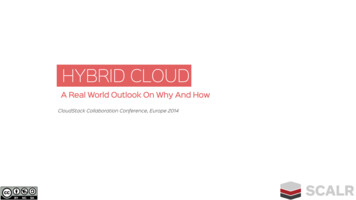
Transcription
HYBRID CLOUDA Real World Outlook On Why And HowCloudStack Collaboration Conference, Europe 2014
MeThomas OrozcoProduct Manager @ Scalr
WHAT’S SCALR?Why Talk About Hybrid Cloud?Open-source EnterpriseCloud ManagementPlatform.All our enterprisecustomers run on hybridcloud.(CloudStack AWS atSamsung, OpenStack AWS at Expedia, NASA)
And youWho are you?What do you do?Image Credit: Bybzee from the Noun Project
WHAT’S “HYBRID CLOUD”?Image Credit: PhotoAtelier (Flickr)
DEFINE: HYBRID CLOUDA system with components deployedacross multiple cloud platforms is saidto be using hybrid cloud.Oftentimes, it’s one public cloud and oneprivate cloud (but this actually haslimited implications).Image Credit: greeblie (Flickr)
WHAT “SYSTEM”?Challenges and success strategies largelydepend on what you are looking atAppOrganizationAt the app level, “operating on a hybridAt the organizational level, “operating acloud” means you have interdependenthybrid cloud” means you have someservices that make up your appresources, possibly independent,distributed across clouds.distributed across clouds.Image Credit: Dane Hetteix, Auda Samora from the Noun Project
TIME FOR STATISTICS!Adoption exists both at the organization and app level25%23%43%25% of enterprises will bedeploying IT workloadsand applications in ahybrid cloud setup by 2015.23% think that hybridcloud is the best executionvenue for cloud-nativeapps (i.e. greenfield).43% think that hybridcloud is the bestexecution venue for ebusiness applications.Private: 11%, Public: 66%.Private: 18%, Public: 39%.Source: Forrester Research, “Cloud Wave 6” Study, 2014
WHY USE HYBRID CLOUD?More reasons than you can think of! The same apply at both levelsCOST OPTIMIZATIONCUSTOM SKUSPERFORMANCEDeploy ephemeral apps (e.g.ad campaigns) and riskyventures to a public cloud.Deploy workloads that requireunusual CPU / RAM / Diskratios to a private cloud withcustom SKUs.Achieve greater performanceby deploying to a privatecloud (e.g. smaller DC implieslower latencies, and usingbare metal cloud is an option).Deploy long term workloads toa private cloud.Or, “buy the base and rent thespike.”Deploy more typicalworkloads to a public cloud.FAILOVER, DR, BACKUPSLEGACY SYSTEMSVENDOR LEVERAGEHost failover resources anddata backups in a separatecloud for redundancy andpossibly cost reduction.Deploy backend resourcesthat integrate with legacy onpremises systems in a privatecloud (latency compliance).Deploy frontend resources ina public cloud.Get a better deal with yourpublic cloud provider byhaving an alternative.COMPLIANCEAND MORE!Deploy regulated workloadsand store regulated data in agold-plated secure privatecloud, use public cloud for therest.There are literally innumerableuse cases for hybrid cloud.
IN A WORD: ALIGNMENTHybrid cloud means you deployworkloads to the cloud that is thebest suited to fit their requirements.Key considerations often revolvearound SLAs and value / cost ratios.Image Credit: Sabine Wollender from the Noun Project
SUCCESS STRATEGIES AT THEAPP LEVELImage Credit: Ched Cheddles (Flickr)
USE CASEWhat are we talking about here?“Hybrid cloud? Everyonewas talking about it, butno one was really doing it.”One application, multiple tiers distributedacross different clouds.Mark Williams, CTO of Redapt,formerly at Zynga where he built zCloud3 Key Success Strategies: Understand infrastructure differences Be mindful of leaky abstractions Avoid vendor lock-inImage Credit: Auda Samora, Callum Egan from the Noun Project
INFRASTRUCTURE“I’ll just use libcloud”Abstraction libraries like libcloud orfog resolve syntactic APIincompatibilities.But don’t miss the forest for thetrees! Semantic incompatibilitiesmatter the most. Account for them!E.g. provisioning times can varyacross clouds, so scaling parametersthat work well on one cloud may notbe appropriate for another one.Image Credit: Edward Boatman, Richard de Vos from theNoun Project“APIs are tiny windowsinto massive, complicatedsystems”Randy Bias, CTO of CloudScaling,built Korea Telecom’s uCloud
ABSTRACTIONS“I’ll just use Docker” (or Chef, or Salt, etc.)Solutions like Docker or Chef let yougreatly simplify application deploymentsand operations, but they are leakyabstractions.E.g. latency across clouds can be quitehigh. Latency within a public cloud mayalready be too high for your workload.Test it!Backend latency can quickly slow atypical Django / Rails app to a crawl.Don’t forget bandwidth costs, too.Image Credit: André Raphael, Richard de Vos, Icomaticfrom the Noun Project, Michael Wyszomierski (Flickr)
LOCK-IN“I wish I hadn’t used DynamoDB”Managed services are the bread andbutter of cloud lock-in (e.g. DynamoDB,SQS )Consider relying on trusted OSSsoftware instead if you intend to usehybrid cloud (e.g. Redis, RabbitMQ)Image Credit: Marwa Boukarim from the Noun Project,Vinoth Chandar (Flickr)
SUCCESS STRATEGIES AT THEORGANIZATION LEVELImage Credit: Ched Cheddles (Flickr)
USE CASEWhat are we talking about here?Entire organization. Numerousindependent apps deployed acrossmultiple clouds.3 Key Success Strategies: Define cloud for your organization Enable users to transition across clouds Encourage them with the right incentivesImage Credit: Dane Hetteix, Callum Egan from the Noun Project
DEFINEWhat cloud? Cloud-native, or just cloud?Cloud can have many meanings, but tofreely distribute across clouds, yourorganization must agree on one.Different clouds encourage differentarchitectures (e.g. cloud-native “cattlevs pets”, traditional “scale-up”).The “big public clouds” are “elastic”,or “scale-out” clouds.Image Credit: Martin Delin, Icomatic from the Noun ProjectUsers of CloudStack shouldbe especially careful.CloudStack accommodatesscale-up workloadsdifferently than most cloudplatforms.
ENABLESupport end-users that want to migrate from a cloud toanotherMost organisations start on apublic cloud and migrate back to aprivate cloud later on.End users expect a solidexperience that matches whatpublic clouds offer.In private cloud,CloudStack “just works”Image Credit: Simple Icons, Apache Software Foundation
ENCOURAGEProvide the right incentives for users to place their workloadswhere you want them toTo achieve organizational hybrid cloudobjectives (e.g. a cost reduction), endusers are the ones that must migrate.Chargeback is an efficient way toincentivize users to move to the cloudwhere your costs are the lowest.But private clouds can also typicallyachieve greater performance thanpublic clouds.Image Credit: TukTuk Design, hunotika from the Noun ProjectZynga was able to cutcloud costs by 2/3 bymoving to zCloud.Studios started movingwhen staying on AWSwould negatively affecttheir P&L.
QUESTIONS?thomas@scalr.com
Open-source Enterprise Cloud Management Platform. All our enterprise customers run on hybrid cloud. (CloudStack AWS at Sa
